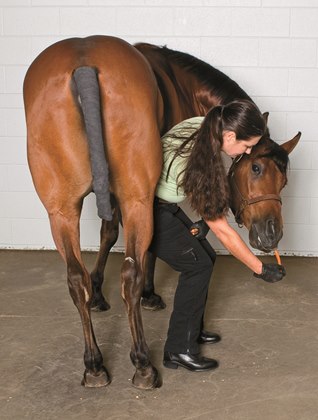
Gymnastic training and mobilization exercises in therapy horses
The objective of this study was to evaluate the effects of dynamic mobilisation exercises (DMEs) and gymnastic training (GYM) in therapy horses. These horses are used to train persons with disabilities and therefor are more due to injures like muscular pain and articular mobility problems. This study shows that it is possible to improve stride quality and increase epaxial muscle size in these horses.
9 Therapy horses were divided in 3 groups: sedentary, DMEs and DMEs plus GYM. Study duration was 3 months and exercises were performed 3 times a week.
The DMEs group performed stretches that have been shown to activate and strengthen m. multifidi. It consisted 3 cervical flexion exercises, a cervical extension exercise and 3 lateral bending exercises. All 10 exercises were repeated 5 times per session and maintained for 5 sec.
The GYM group performed also DMEs and additionally exercises to recruit and strengthen the abdominal muscles and pelvic-stabilizing muscles. These exercises were: pelvic tilting, backing up (10 steps), walking around tight turns (3 reps. left / right) and stepping over obstacles at walk (40 cm for 10 min.).
Stride length increased significantly in the GYM group and tracking distance was significantly longer in this group than in sedentary or DME groups. Indicating improved gait quality. Cross-sectional area of m. multifidus increased significantly in both groups that performed DMEs. This is beneficial in preventing instability of the intervertebral joints and thus protecting against facet joint osteoarthritis.
> K. de Oliveira et al. / Journal of Equine Veterinary Science (2015) 1–6 All rights reserved to 2015 Elsevier Inc. Click here for the J-EVS summary


